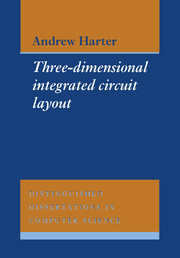Book contents
- Frontmatter
- Abstract
- Preface
- Contents
- List of Figures
- List of Plates
- List of Tables
- List of Algorithms
- Glossary of Terms
- 1 Introduction
- 2 Two-Dimensional Chip Design
- 3 Three-Dimensional Chip Technology
- 4 Three-Dimensional Circuit Topology
- 5 Three-Dimensional Cell Tessellation
- 6 Three-Dimensional Abutment System
- 7 Abutment System Configuration
- 8 Abutment System Evaluation
- 9 Conclusions
- A Layout Editor Configuration
- B Layout System Data Structures
- C Cell Description Rules
- D Circuits
- References
- Index
1 - Introduction
Published online by Cambridge University Press: 05 May 2010
- Frontmatter
- Abstract
- Preface
- Contents
- List of Figures
- List of Plates
- List of Tables
- List of Algorithms
- Glossary of Terms
- 1 Introduction
- 2 Two-Dimensional Chip Design
- 3 Three-Dimensional Chip Technology
- 4 Three-Dimensional Circuit Topology
- 5 Three-Dimensional Cell Tessellation
- 6 Three-Dimensional Abutment System
- 7 Abutment System Configuration
- 8 Abutment System Evaluation
- 9 Conclusions
- A Layout Editor Configuration
- B Layout System Data Structures
- C Cell Description Rules
- D Circuits
- References
- Index
Summary
Thesis aims
A study of three-dimensional integrated circuit layout is presented in this dissertation. Three-dimensional integrated circuits are those in which active devices such as transistors are fabricated in each of at least two vertically stacked semiconducting planes. An evaluation of the potential benefits of using three-dimensional integration is carried out. Such benefits include greater layout densities, shorter interconnection lengths and faster circuits. Emphasis is placed on considering the layout methods required to use three-dimensional fabrication techniques and to accrue the above benefits.
Three-dimensional circuits are one of a number of recent developments in integrated circuit construction techniques to have stimulated interest. Other developments include the use of a variety of semiconductor and wiring materials for faster transistors and connections, and enhanced processing techniques to improve yield and reduce transistor geometries. This enables both physically larger and logically more complex circuits to be integrated. These developments do not present any new layout problems. The search for better, more automated layout continues independently of such technological advances. The same is not true in the three-dimensional domain. The juxtaposition of devices in three dimensions presents an inherently different set of connection properties to the two-dimensional case, since a device may now have neighbours above and below in addition to those in the semiconducting plane. Layout in three dimensions requires new techniques to fully exploit this property.
Since three-dimensional fabrication techniques were first demonstrated in the early eighties [Gibbons 80], two areas of research have been explored. The primary research has concentrated on the necessary fabrication techniques.
- Type
- Chapter
- Information
- Three-Dimensional Integrated Circuit Layout , pp. 1 - 14Publisher: Cambridge University PressPrint publication year: 1991



